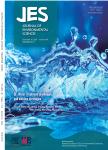Distribution and chemical speciation of arsenic in different sized atmospheric particulate matters
分发和在不同大小的大气的微粒事的砷的化学种形成作者机构:State Key Laboratory of Environmental Chemistry and EcotoxicologyResearch Center for Eco-Environmental SciencesChinese Academy of SciencesBeijing 100085China Hebei Key Lab of Power Plant Flue Gas Multi-Pollutants ControlDepartment of Environmental Science&EngineeringNorth China Electric Power UniversityBaoding 071000China
出 版 物:《Journal of Environmental Sciences》 (环境科学学报(英文版))
年 卷 期:2021年第33卷第10期
页 面:1-7页
核心收录:
学科分类:07[理学] 070602[理学-大气物理学与大气环境] 0706[理学-大气科学]
基 金:funded by the National Key R&D Program of China(No.2018YFB0605101) the National Natural Science Foundation of China(Nos.22076198 and 91543107) the Fundamental Research Funds for the Central Universities(No.2017ZZD07)
主 题:Arsenic Particulate matters Speciation Size distribution
摘 要:The distribution and chemical speciation of arsenic(As)in different sized atmospheric particulate matters(PMs),including total suspended particles(TSP),PM_(10),and PM_(2.5),collected from Baoding,China were *** average total mass concentrations of As in TSP,PM_(10),and PM_(2.5)were 31.5,35.3,and 54.1μg/g,respectively,with an order of PM_(2.5)PM_(10)TSP,revealing that As is prone to accumulate on fine *** to the divergent toxicities of different As species,speciation analysis of As in PMs is further *** of previous studies mainly focused on inorganic arsenite(iAs^(Ⅲ)),inorganic arsenate(iAs^(Ⅴ)),monomethylarsonate(MMA),and dimethylarsinate(DMA)in PMs,while the identification and sensitive quantification of trimethylarsine oxide(TMAO)were rarely *** this study,a high-performance liquid chromatography coupled to inductively coupled plasma mass spectrometry system was optimized for As speciation including TMAO in *** anion exchange column was used to separate MMA,DMA and iAs^(Ⅴ),while a cation exchange column to separate TMAO and iAs^(Ⅲ).Results showed that iAs^(Ⅴ) was the dominate component in all the samples,corresponding to a portion of 79.2%±9.3%of the total extractable species,while iAs^(Ⅲ),TMAO and DMA made up the remaining 21%.Our study demonstrated that iAs^(Ⅲ) accounted for about 14.4%±11.4%of the total extracted species,with an average concentration of 1.7±1.6 ng/m^(3).It is worth noting that TMAO was widely present in the samples(84 out of 97 samples),which supported the assumption that TMAO was ubiquitous in atmospheric particles.



